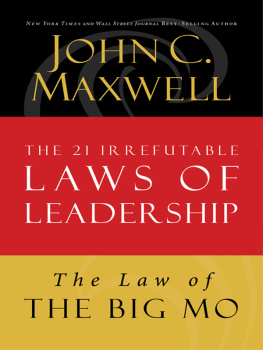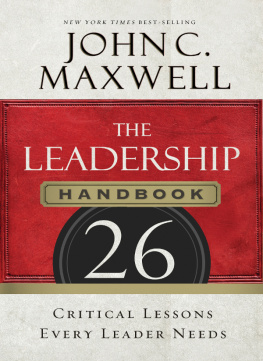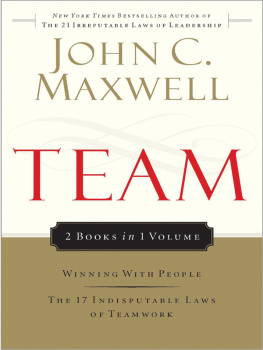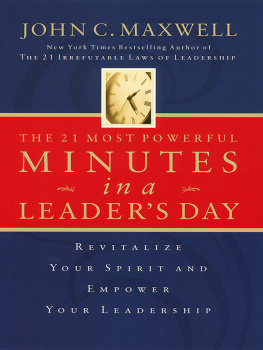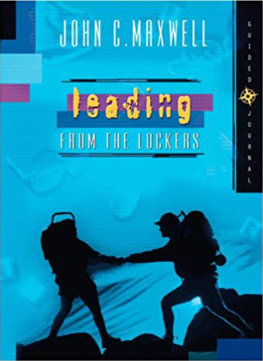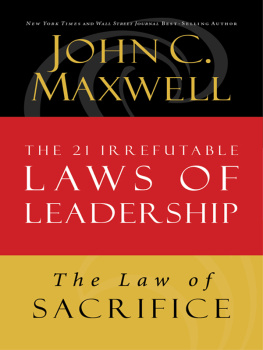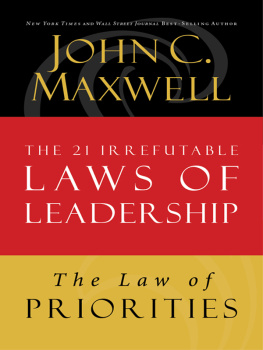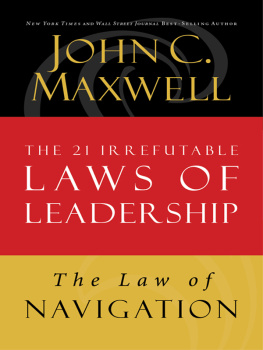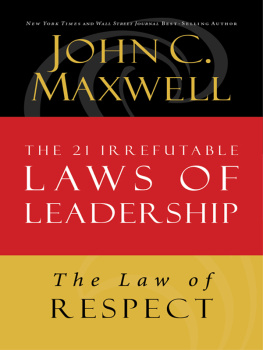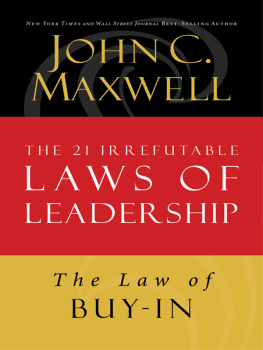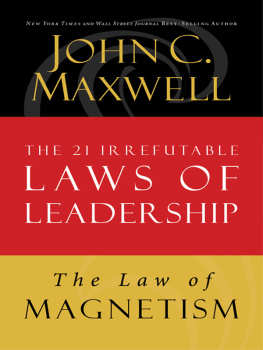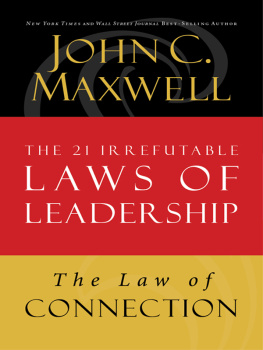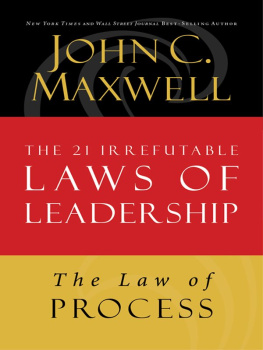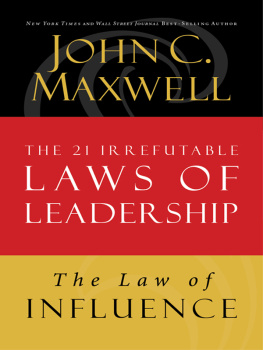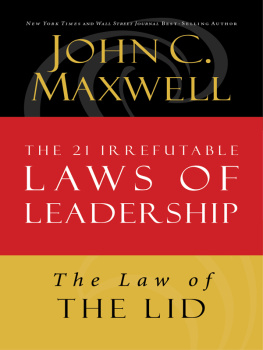
1998 and 2007 by John C. Maxwell
This ebook is derived from The 21 Irrefutable Laws of Leadership, by John Maxwell, 1998 and 2007 by Maxwell Motivation, Inc., a Georgia corporation.
All rights reserved. No portion of this book may be reproduced, stored in a retrieval system, or transmitted in any form or by any meanselectronic, mechanical, photocopy, recording, scanning, or otherexcept for brief quotations in critical reviews or articles, without the prior written permission of the publisher.
Published in Nashville, Tennessee, by Thomas Nelson. Thomas Nelson is a trademark of Thomas Nelson, Inc.
Thomas Nelson, Inc. titles may be purchased in bulk for educational, business, fund-raising, or sales promotional use. For information, please e-mail SpecialMarkets@ThomasNelson.com.
Published in association with Yates & Yates, LLP, Attorneys and Counselors, Orange, California.
Scripture quotations noted CEV are from THE CONTEMPORARY ENGLISH VERSION.
1991 by the American Bible Society. Used by permission.
Scripture quotations noted The Message are from The Message: The New Testament in Contemporary English. 1993 by Eugene H. Peterson.
ISBN 978-0-7852-7431-5 (HC)
ISBN 978-1-4185-3831-6 (ebook)
ISBN 978-1-4002-7575-5 (ebook of Chapter 16)

This book is dedicated to Charlie Wetzel, my writing partner since 1994. Together weve written more than forty books, and Ive enjoyed our collaboration on every one. As I have labored to add value to others by identifying and teaching leadership principles, Charlie, you have added value to me and my efforts. Your insights and skills as a wordsmith have been enjoyed by millions of readers. As a result, you have made a greater impact on more people than has anyone else in my inner circle. For that I thank you.
CONTENTS


Thank you to the thousands of leaders around the world who learned and sometimes challenged the laws of leadership, thus sharpening my thinking.
Thank you to the team at Thomas Nelson who gave me the chance to revise and improve this book, and especially to Tami Heim for her strategic leadership and to Victor Oliver who was instrumental in the development of the original concept.
Thank you to Linda Eggers, my executive assistant, and her assistant, Sue Caldwell, for their incredible service and willingness to go the extra mile every day.
Thank you to Charlie Wetzel, my writer, and Stephanie, his wife, with-out whose work this book would not have been possible.

Momentum Is a Leaders Best Friend
If youve got all the passion, tools, and people you need to fulfill a great vision, yet you cant seem to get your organization moving and going in the right direction, youre dead in the water as a leader. If you cant get things going, you will not succeed. What do you need in such circumstances? You need to look to the Law of the Big Mo and harness the power of the leaders best friend: momentum.
STARTING FROM SCRATCH
If ever there was a person with talent and vision, it was Ed Catmull. As a boy, Catmull had grown up wanting to become an animator and filmmaker. But when he went to college, he had a realization: he wasnt good enough. He promptly changed his focus to physics and computer science, earning a bachelors degree in each during the next four years. After working for Boeing for a few years, he decided on graduate school and enrolled in a new field within computer sciencecomputer graphics. There he discovered that he could draw with the aid of a computer. It rekindled his dream to make movies. Even before he earned his PhD in 1974, Catmull was developing innovative software and looking for opportunities to make computer-generated movies.
In 1979, filmmaker George Lucas hired Catmull to run the computer graphics division of Lucasfilm Ltd. For the next seven years Catmull hired some of the best technicians in the country and attracted other talent, such as John Lasseter, who had once worked at Disney. Catmulls group broke new ground technologically and produced some incredible work, such as the Genesis sequence in Star Trek II: The Wrath of Khan. However, the division was very expensive to keep running. Catmull tried to convince Lucas to let him try to make computer-generated feature films, but the technology was still in its early stages and too expensive. Instead, Lucas decided to sell the division. In 1986 Steve Jobs bought it, paying five million dollars for it and putting an additional five million dollars into the company. He named it Pixar.
BABY STEPS
While it was struggling to become profitable, Pixar began making short films to demonstrate the power of its technology. The first was called LuxoJr. It shows two animated desk lamps interacting as a parent and child would. Typically in those days after showing any kind of film demonstrating computer animation, filmmakers were asked a bunch of technical questions by industry experts who watched the filmabout the algorithms they wrote or the software they used. Catmull and Lasseter knew they had made a significant step forward when one of the first questions asked was whether the parent lamp was the mother or the father. Thats when they knew they had connected with their audience and succeeded in telling a story, not just showing off new technology. Lasseter says,
We had absolutely no money, no computers, no people, no time to do the fancy flying camera moves that you were seeing and all the glitzy tracing and all that stuffwe just had no time. We just locked the camera down and had no background, but it made the audience focus on what was important in the filmthe story and the characters. So for the first time, this film was entertaining people because it was made with computer animation.
Luxo Jr. was so good that it was nominated for an Academy Award. But Catmull and his team were still a long way from achieving his dream of creating a full-length feature film. The companys greatest challenge at that time was merely surviving. Pixar continued to develop technology. The company also gained recognition and received awards, including its first Oscar in 1989. To help make ends meet, the team started to make computer- animated commercials. (You may remember a commercial with a Listerine bottle boxing. That was Pixars work.) But it was difficult for Pixar to gain significant momentum. The firm was moving forward, but only very slowly.
FINALLY, SOME CREDIBILITY
Then in 1991, because of the credibility Pixar had earned, it got a significant break. The leaders thought the company was ready to take its next big stepcreating a one-hour television special. Lasseter approached Disney, his former employer, to pitch the idea. The response amazed him. Disney offered Pixar a contract to create three full-length feature movies using computer animation. Disney would fund and distribute the projects; Pixar would create them and receive a percentage of the profits.
Pixar finally had an opportunity to fulfill Catmulls vision, but the company was still far from realizing it. The company got to work on what would become
Next page
